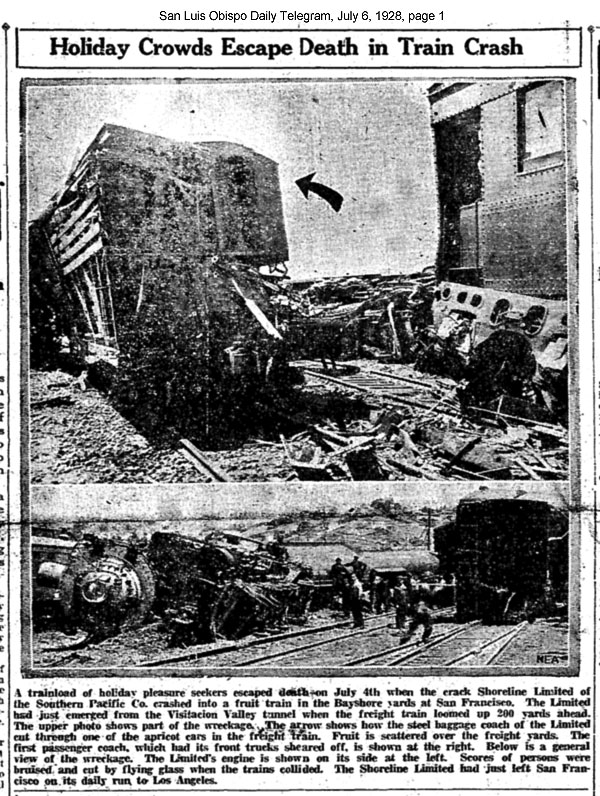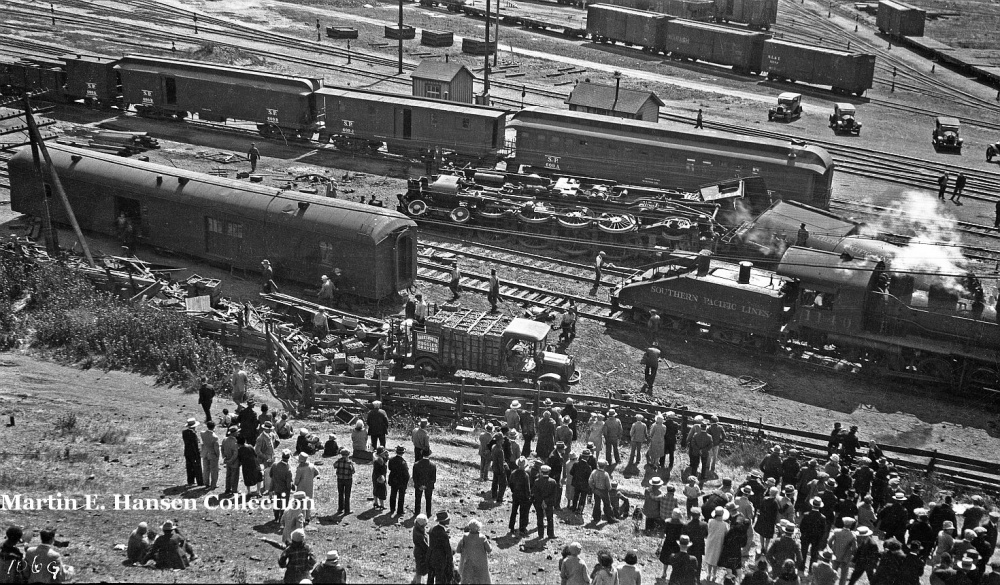The Saga of the 4355
By Fred Boland, Machinist 1928-1980
Bayshore Shops, Southern Pacific Railroad
The Saga of the 4355 As the years went by the SP would come out with bigger and stronger locomotives. In 1924 a new type of locomotive came out. It was a 4-8-2 wheel arrangement, called the Mountain type, maybe because other railroads used theirs on their mountain divisions. Ours had 73" drivers, weighed 246,000 lbs on the drivers and 6000 lbs on the trailing truck, which had a booster. It was good on passenger and fast freight. It wasn't as good in drag service because of the relatively high wheels. The 2-10-2 3600 - 3700's, the mallets and others with 63" drivers were better suited for drags.
The first set, 4300 to 4327, were bought new from Alco's Schenectady works. In 1925 the company started building their own in the Sacramento shops. The 4328, all shiny, big and beautiful stood in the usual pose with the Collis P. Huntington #1 on the next track. If memory serves right, there was a silent news reel showing the two rolling down the track side by side.
In the bitter Depression year of 1930 the final set, 4367 to 4376 were built, the last, except for the 1307 to 1314 0-8-0's, of the home grown products started in the 1870's. By this time it seemed to be like the diesel age, assembling products of other manufacturers from all over the country, instead of forging, casting, cutting, riveting, machining and assembling their own parts.
In the latter part of 1927 and early 1928 the 4351 to 4358 were built. They initiated the big locomotives handling the long passenger runs between San Francisco and Los Angeles without a change at San Luis Obispo. The local to SLO, the Daylights and the mail train continued to be handled mostly by the heavy Pacifics of the 4-6-2 wheel arrangement.
In those days most people traveled by train or bus. It wasn't till sometime after 1935 that the Varney 8 passenger airplanes were put in service, the forerunner of United Airlines. If you needed a quick lift, you dickered with a private pilot.
On July 4th,1928, the 4355 headed the Daylight to Los Angeles. As it broke out of Bayshore tunnel at around 45 miles an hour, that home and distant signal at the tunnel mouth was set against them. Either the towerman thought he had more time, or the switch engine was slow to respond to permission to go, or maybe the new, more powerful engine under a good throttle artist cut the running time. A drag was crossing over to go into town. The 4355 hit a stock car of apricots in the train at an angle and tipped over. The engineer was scalded and in a few days died. The fireman fared better, but was also burned.
After the post accident investigation, that yellow warning signal was moved 600 ft. inside the tunnel, so engineers would know what to expect at the mouth.
Mike Schmidt, labor foreman, bossed the cleanup crew. For many months he brought a pint of apricot brandy as a part of his lunch.
The 4355 was towed to the Bayshore backshop, because they could never get it to Los Angeles. It was the first, and for years the only big power to get into the Bayshore shop, as they were set up to handle the smaller power, eight, ten, and twelve wheelers, moguls, consolidations and prairies. It wasn't until 1930 that a 2-8-2 Mikado made it.
I started at Bayshore in September of that year, and I remember big burly Jack Slaven, Master Mechanic, 6' 6" and 275 lbs, in his black arm bands, watching the boys trying to straighten the tender rear sheet with the wheel press. After 3 or 4 unsuccessful tries, he calmly said "We will order another one."
In due course all the kinked rods, smashed air pumps, etc. were repaired, and after a trial trip to San Jose and back, the 4355 was put back on the long runs.
On the second trip, starting out of Redwood City, one of the two mainpins, about 10" in diameter broke just inside the fit in the wheel center. She stripped herself on that side, and back in the shop she went. Today, with electric analysis and black light, whereby a crack can be detected anywhere in a big piece of metal like an axle, this wouldn't happen. In those days all we had was whiting to paint critical parts with. If a crack was present, after a while the grease in the crack would ooze out, and show where it was.
After coming out she led a fairly quiet existence, but always the "hoodoo" was present. Many of the parts had been strained beyond the elasticity point.
Sometime in the late 1930's she was sitting on the Mission Bay ready, or outbound track. You never moved a locomotive that had been standing for some time without opening the cylinder cocks to let the water out, as the piston with water between it and the cylinder head would inevitably knock the head out. Great clouds of steam would accompany this.
Well, the crew climbed on to take her to the depot to tie on to either the Coaster or the Lark. The usual cloud of steam obscured everything, but in a rift, the fireman saw something that froze him. "Hey!" he hollered, "You are going the wrong way!" Sure enough, for some unknown reason, that old head of an engineer had put his reverse gear in the wrong direction, but it was too late. Into the turntable pit she went. They had to burn the whistle rod in half to stop the yowling.
Tom Chapman was in on this wreck. They jacked it up and put tie cribbing and rails under it, and got it out.
On October 19, 1935 the 4355 was the road engine on the Lark, train 75 to San Francisco. Being a very heavy train, 2451 was double heading it and would be useful going up the grade beyond Chatsworth where so many good pictures of the colorful Daylight, inaugurated in 1937 have been taken. At a road crossing between Glendale and Burbank the train hit a sand truck. I don't know the damages that occurred to 4355, but 2451 left the rails, was atop a sand mound, leaning over. Her tender came to rest alongside the engine, upside down and facing backward.
In 1940 at the start of the Treasure Island Fair, a new train was inaugurated at Oakland Pier. Called "The 49er" because it took 49 hours to and from Chicago. It used steam and complimented the dieselized streamliner which took 39 hours, and at that time, it "sailed" as the publicity put it, three times a week.
SP President Mercier and all officials, the scantily clad bathing beauties, the press and movie cameras were all there. No engine showed up and things were delayed. We at Bayshore heard a 4300, polished up for the train had taken a dive into the Oakland turntable pit. We understood it was our "hoodoo" engine, but it turned out to be 4315. Of course the first available passenger engine, dirty or not was turned and used. A 4-6-2 Pacific wound up taking the honors.
I don't remember any further mishaps and she must have shook off the hoodoo, because she was scrapped in the years that final engine scrapping took place.


Ralph Demorro recorded this shot of the aftermath from the top of the cut outside the tunnel. Note the truck loaded with apricot crates salvage from the demolished stock car. Thanks to Martin Hansen for providing the photo.
